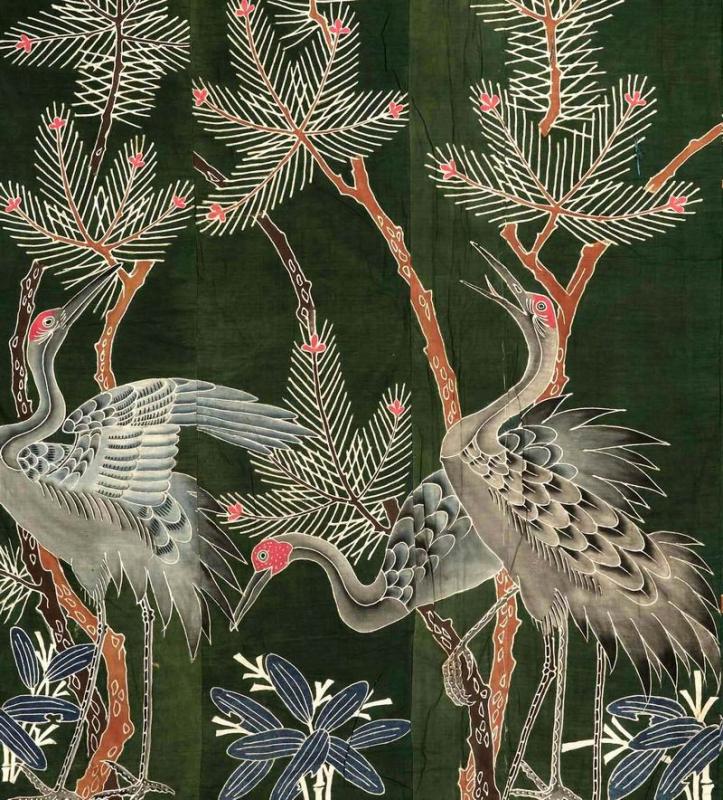Back
silk futon cover, Japan, Meiji (circa 1900), cm 182x152. This is a celebratory textile created to form part of a bride's wedding trousseau. Because futonji were an important aspect of the ceremonial inauguration of a couple's new life together, auspicious and meaningful symbols were purposefully chosen to decorate such pieces. Here we see a magnificently realized rendering (in the tsutsugaki technique) of three cranes amid small bamboos and pine needles. The pine is ever green (and lives 1000 years according to legend), so a symbol of longevity; the bamboo is resilient as it bends but does not break under winter snow, and symbolize bravery. The crane is a symbol of beauty and elegance in Japan, but also of trustful fidelity. Most importantly for the new bride and groom, is this last fact: cranes, they say, mate for life. Noteworthy is the fact that this futonji is not made of indigo cotton - as many are - rather of soft ‘tsumugi’ silk on a musky green ground. It has been used, so no wonder it shows signs of age, particularly in the silk red lining, but this does not detract from its beauty. i just love the articulate presence of the cranes, the stiff crudeness of the rendering, and the folksy rendition of these classic subjects. Simply great.
price:
SOLD
- Home
- Antique Rugs by Region
- Category
- Profiles
- Post Items Free
- Albums
- Benaki Museum of Islamic Art
- Budapest: Ottoman Carpets
- Gulbenkian Museum
- Islamic Carpets. Brooklyn
- Islamic Textiles. Brooklyn
- Konya Museum: Rugs
- MKG, Hamburg
- MMA: Caucasian Carpets
- MMA: Mamluk Carpets
- MMA: Mughal Indian Carpets
- MMA: Ottoman Carpets
- MMA: Safavid Persian Carpets
- MMA: Turkmen Rugs
- McCoy Jones Kilims
- Ottoman textiles. Met
- Philadelphia Museum
- Rugs and Carpets: Berlin
- Seljuqs at the Met
- TIEM, Istanbul: Carpets
- V&A: Classical Carpets
- Vakiflar Carpets: Istanbul
- Baluch Rugs: Indianapolis
- Gallery Exhibitions
- Jaf an Exhibition
- Alberto Levi Gallery
- Andean Textile
- Christie's London: 2016
- Francesca Galloway
- HALI at 40
- ICOC Washington, DC 2018
- Jajims of the Shahsavan
- London Islamic Week April, 2018
- Mongolian Felts
- Navajo Rugs: JB Moore
- Persian Piled Weavings
- SF Tribal & Textile Art Show 2020
- SF Tribal 2019
- Sotheby's: C. Alexander
- Turkish Prayer Rugs
- Turkmen Main Carpets ICOC 2007







